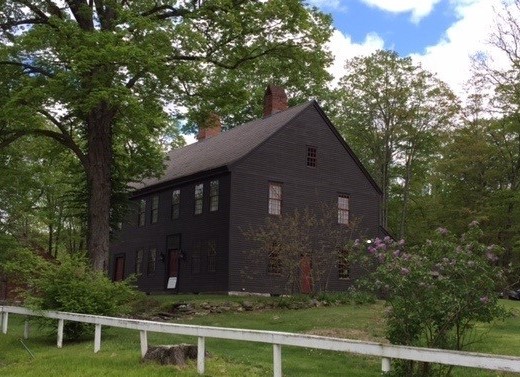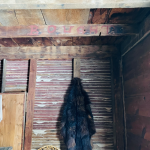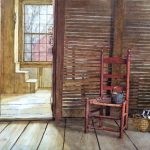By Christine Adams
Adaptive reuse of historic buildings has become more and more commonplace in recent years, in both urban and rural areas. Think of loft apartments in what was once a meat-packing plant or sprawling barns renovated into charming homes with soaring ceilings and hand-hewn beams framing modern kitchens and living spaces. In the small town of Kent, Connecticut, however, repurposing old buildings is not a new concept.
The present home of the Kent Historical Society—Seven Hearths—has satisfied the varied needs of its inhabitants for over 272 years. It has served as a dwelling house, a store and trading post, a school, tenant farmers housing, and a leased home. In addition, it has been an art studio and gathering place for creative minds. Situated in the Flanders Historic District of Kent—about two miles north of the contemporary Town Center—Seven Hearths is now open to the public as a house museum. It is unusual because of its large scale—an imposing yet welcoming brown colonial. Its furnishings and interior detail reflect the many incarnations of the house, the lives of the occupants, and the respective eras of Kent’s history.
A House for Many Purposes
John Beebe Jr. built the structure in 1751 for dual purposes: a dwelling and a place of commerce. The two front entrances served each purpose and interior doors separated the public from the private. The north part of the structure included a store, with an upstairs fur trading post, reflecting the original barter economy of the settlement of Kent, when money was not always readily circulated.
The Beebe Family held the house until May 19, 1818, when they sold it to Thomas Grant Northrop. The Northrops rented out the house and in the 1830s it became an academy. According to the Kent Conservation Commission, “for almost two hundred years, the mandatory education of Kent’s school-aged children was provided in 14 separate one-room school houses scattered throughout the town.” There were also larger schools, most notably the “Flanders Academy” housed at Seven Hearths.
Later, it was a two-family tenant farmers’ house—convenient due to the original two entry design. As its inhabitants did not hold the legal title to the house, it gradually fell into disrepair until the serendipitous arts movement came to Kent. An art-minded couple—the painter George Laurence Nelson and art critic Helen Redgrave Nelson—bought the house in 1919, seeking a bucolic and affordable location in which to live their creative lives.
The Final Owners: The Nelsons
In honor of the house’s seven fireplaces, George Laurence Nelson named his new home “Seven Hearths.” According to Nelson, he and his wife “wanted a name that would reawaken in us something of our early enthusiasm…It suggests much that is pleasant in the nostalgic groove of the past and serves moreover to conjure up the feeling of home and warmth we first visualized in spite of the apparent wreckage and neglect.”
During the century of Northrop stewardship, the house was well maintained, yet never renovated to a great extent. The counterintuitive benefit of its life as a rental is that the historic structure remained largely unaltered when Nelson purchased it. He described Seven Hearths as only an artist could, paneled in ancient pine, “the fine rich tone that age alone can give.” Nelson went through great lengths to retain that authentic patina in his own renovation projects, as he “waited for a rainy day when the curled clapboards softened and could be nailed flat again without cracking. [He] could not bring himself to part with them and their old wrought iron nails. They lent texture to the surface which new siding never possesses. To an artist, texture is important. [He] had seen too many old houses made over to such an extent that they looked like the new colonial reproductions seen in our city suburbs.”
- Fur trading post section of Seven Hearths. Note the BOUGHT written on the beam – Kent Historical Society
- Still life art of the fur trading post at Seven Hearths – Deborah Chabrian
While Nelson was renovating the second floor to make way for a bathroom, he discovered the literal writing on the wall: “mink and fox and other skins, marked in blue chalk on the beams. Large painted letters indicated the bought and sold sections.” He uncovered the remnants of the trading post from two centuries earlier. In 2009, the Connecticut Trust for Historic Preservation awarded the Kent Historical Society a grant to perform a thorough Historic Structures Report. Since then, Kent Historical Society has removed all the 20th century components of the fur trading area, resulting in a rare interpretation of an 18th-century fur trading and barter system economy—only the second such museum display in the country.
Home of the Kent Historical Society
Upon his death in 1978, Nelson bequeathed Seven Hearths to the Kent Historical Society, so the warmth of its home fires could be shared with the community. By preserving its stories, the stately structure has become a repository of Kent’s collective civic memory. The building is an artifact itself—much like an architectural piece of art—and a tangible connection to the past 272 years of Kent’s history. It seems appropriate that an artist was its final private resident, as a vibrant creative community still enriches the town. Nelson’s palettes still grace the old store—one of his easels now holds an Ammi Phillips (“The Kent Limner”) portrait. Wood finishing paints still mark the walls of Nelson’s second floor workshop where he framed artwork and performed conservation tasks to supplement his income.
The symbolism of the hearth is universal in its meaning: comfort, warmth, and welcome. When John Beebe Jr. created seven of them in Flanders, keeping warm posed a significant challenge during the winter months in Kent. At Seven Hearths, it has become a symbol of community welcome, where those who know and love Kent can gather in civic engagement with a mutual respect of the town’s rich history and culture. The building has inadvertently come full circle in its purpose, all the while retaining the elements of its many historical lives by providing a public place where Kent’s citizens and friends can gather—much as they did in the 1750s when gathering in the store to trade domestic goods.
Christine Adams serves on the Board of Trustees for the Kent Historical Society. A resident of New Preston, she is the author of an anthology of poetry and also works as a researcher for the Gunn Historical Museum.














